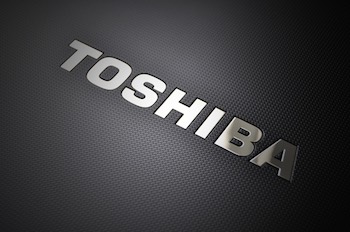 Toshiba Corporation (TYO:6502) of Tokyo, Japan, is a multinational conglomerate focusing on the development and manufacture of information technologies, electronic components, industrial systems, consumer electronics and home appliances, among other areas of tech. The corporation has been experiencing turbulent business headwinds in recent days, thanks in large part to a 7.37 billion yen ($62.32 million USD) fine imposed by the Japanese government in response to a major accounting scandal. For its part, Toshiba has filed suit against five former executives tied to the scandal, seeking to recoup 3.2 billion yen ($26.94 million USD) in compensation claims. In late January, Toshiba shares hit a 35-year low after announcing that it was looking into whether to write down its Westinghouse Electric Company business, of which Toshiba holds a majority ownership stake.
Toshiba Corporation (TYO:6502) of Tokyo, Japan, is a multinational conglomerate focusing on the development and manufacture of information technologies, electronic components, industrial systems, consumer electronics and home appliances, among other areas of tech. The corporation has been experiencing turbulent business headwinds in recent days, thanks in large part to a 7.37 billion yen ($62.32 million USD) fine imposed by the Japanese government in response to a major accounting scandal. For its part, Toshiba has filed suit against five former executives tied to the scandal, seeking to recoup 3.2 billion yen ($26.94 million USD) in compensation claims. In late January, Toshiba shares hit a 35-year low after announcing that it was looking into whether to write down its Westinghouse Electric Company business, of which Toshiba holds a majority ownership stake.
It’s perhaps possible that these corporate woes are causing Toshiba to consider shoring up its operations in a couple of tech sectors. In December, the company announced that it would be selling a majority stake in its medical equipment business, which could net the company more than 500 billion yen (more than $4 billion USD) if it sells 80 percent of that business. Financial analysts have suggested that Toshiba may want to consider closing up its hard disk drive (HDD) operations, which has seen declining shipments in recent quarters, in order to focus on the more rapidly developing flash memory sector. The conglomerate has also announced that it 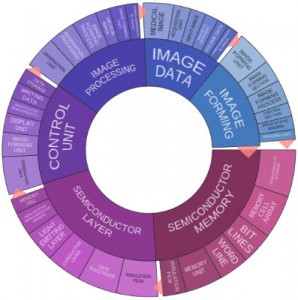 will accept bids to sell part of its non-core semiconductor operations.
will accept bids to sell part of its non-core semiconductor operations.
Toshiba exists among the giants of the U.S. patent landscape, placing sixth among all companies in terms of patents received from the U.S. Patent and Trademark Office in 2015; it took home 2,627 U.S. patents in 2015, topping regional tech rivals Sony Corp. (NYSE:SNE) and LG Electronics (KRX:066570). This sixth-place showing sees Toshiba improving upon its 2014 rankings, where it took in the seventh-most U.S. patents. In terms of total U.S. patents, however, Toshiba actually earned less than it did in 2014, when it brought in 2,850 patents. In the three months leading up to this writing, Toshiba earned 677 U.S. patents, according to Innography’s patent portfolio analysis tools. The text cluster indicates that there remains a great deal of focus on developing semiconductor layer and memory technologies at Toshiba, although activities in control units, image processing and image data are also prominent.
Toshiba’s Recent Patents: From Patient Record Management to Retrieving Handwritten Documents
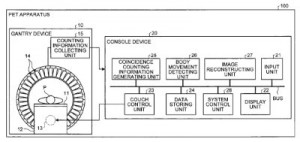 Despite Toshiba’s interest in selling its medical equipment business, we found plenty of such innovations reflected in our recent survey of the company’s issued patents, including U.S. Patent No. 9239393, entitled Positron Emission Computed Tomography Apparatus and Image Processing Apparatus. It protects a positron emission computed tomography apparatus having a detector that detects annihilation radiations released from a subject, a coincidence counting information generating unit that searches for sets of counting information which counted a pair of annihilation radiations at substantially the same time, a body movement detecting unit that calculates each pair annihilation coordinate on a line of response to detect temporal changes in the subject’s body movement and an image reconstructing unit that partitions the time series list of coincidence counting information into a plurality of phases based on the temporal changes of the subject’s body movement. This innovation improves the use of external positron emission computed tomography (PET) devices and addresses issues of alignment errors which can occur between external PET equipment and infrared light reflection markers placed on a patient. A technology designed to prevent the collapse of applications providing health record management is described within U.S. Patent No. 9220464, issued under the title Medical Information Management Device. It discloses a medical information management device having a display circuitry that displays a screen of a medical application, a monitoring item setting circuitry that sets a plurality of monitoring items from information items used in the medical application, an acquisition circuitry that acquires a value belonging to the plurality of monitoring items, a determination circuitry that determines whether the value acquired by the acquisition circuitry follows matching determination rules corresponding to the medical application and an alerting circuitry that causes the display circuitry to display an alert when the acquired values do not follow the matching determination rules. This innovation reduces the risk of misdiagnosis because medical records are inappropriately assigned to the wrong patient.
Despite Toshiba’s interest in selling its medical equipment business, we found plenty of such innovations reflected in our recent survey of the company’s issued patents, including U.S. Patent No. 9239393, entitled Positron Emission Computed Tomography Apparatus and Image Processing Apparatus. It protects a positron emission computed tomography apparatus having a detector that detects annihilation radiations released from a subject, a coincidence counting information generating unit that searches for sets of counting information which counted a pair of annihilation radiations at substantially the same time, a body movement detecting unit that calculates each pair annihilation coordinate on a line of response to detect temporal changes in the subject’s body movement and an image reconstructing unit that partitions the time series list of coincidence counting information into a plurality of phases based on the temporal changes of the subject’s body movement. This innovation improves the use of external positron emission computed tomography (PET) devices and addresses issues of alignment errors which can occur between external PET equipment and infrared light reflection markers placed on a patient. A technology designed to prevent the collapse of applications providing health record management is described within U.S. Patent No. 9220464, issued under the title Medical Information Management Device. It discloses a medical information management device having a display circuitry that displays a screen of a medical application, a monitoring item setting circuitry that sets a plurality of monitoring items from information items used in the medical application, an acquisition circuitry that acquires a value belonging to the plurality of monitoring items, a determination circuitry that determines whether the value acquired by the acquisition circuitry follows matching determination rules corresponding to the medical application and an alerting circuitry that causes the display circuitry to display an alert when the acquired values do not follow the matching determination rules. This innovation reduces the risk of misdiagnosis because medical records are inappropriately assigned to the wrong patient.
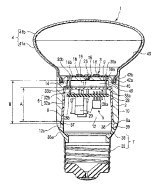 A Toshiba subsidiary focused on developments in lighting technologies was recently assigned U.S. Patent No. 9234657, titled Lamp Having Outer Shell to Radiate Heat of Light Source. It claims a lamp device having a metallic device body with heat conductive properties and including a light source support, a heat radiating surface, an edge projecting further than the light support’s flat surface and forming an obtuse angle with that surface, a receiving portion partially composed by the light support’s side surface, a board thermally connected to the light source support and fixed by a screw, a plurality of light-emitting elements mounted on the board, a cover for the device body, a base portion which is power-feedable to the light-emitting elements and a light-reflecting member positioned in the receiving portion. This innovation improves the cooling performance of LED lamps and prevents overheating of the light-emitting circuitry.
A Toshiba subsidiary focused on developments in lighting technologies was recently assigned U.S. Patent No. 9234657, titled Lamp Having Outer Shell to Radiate Heat of Light Source. It claims a lamp device having a metallic device body with heat conductive properties and including a light source support, a heat radiating surface, an edge projecting further than the light support’s flat surface and forming an obtuse angle with that surface, a receiving portion partially composed by the light support’s side surface, a board thermally connected to the light source support and fixed by a screw, a plurality of light-emitting elements mounted on the board, a cover for the device body, a base portion which is power-feedable to the light-emitting elements and a light-reflecting member positioned in the receiving portion. This innovation improves the cooling performance of LED lamps and prevents overheating of the light-emitting circuitry.
Techniques for analyzing handwritten documents in response to database queries is discussed in U.S. Patent No. 9230181, which is titled Handwritten Document Retrieval Apparatus and Method. It discloses a handwritten document retrieval apparatus having a processor and a memory storing instructions causing the processor to execute acquisition of a document including handwriting data having a set of a stroke, separation of the document into a character part and a separate part, extraction of feature values for each part and retrieval of a handwriting character based on the feature values. This system is capable of retrieving handwritten documents stored in a database which match the quality of a handwritten query input from a user.
Advances in solar energy collection are always intriguing, which is why we took note of U.S. Patent No. 9231132, entitled Process for Manufacturing Solar Cell Equipped with Electrode Having Mesh Structure. This protects a process for manufacturing a solar cell including a photoelectric conversion layer containing p-type and n-type semiconductors, a first electrode layer made of metal and formed on a light incident side surface of the photoelectric conversion layer and a second electrode layer formed on a surface opposite the light incident side surface. The innovation provides for increased photoelectric conversion efficiency with the use of inexpensive materials.
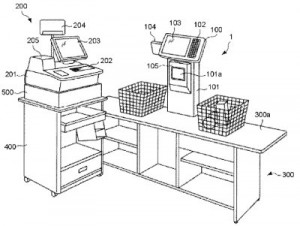 Toshiba is even involved with R&D for point-of-sale (POS) receipt printers, as is evidenced by the issue of U.S. Patent No. 9216596, which is titled Printing Apparatus and Commodity Information Processing Apparatus. The printing apparatus protected here has a conveyance section which conveys roll paper, a print head that carries out printing with color erasable ink on the roll paper when conveyed forward, an erasing head that erases the color of the color erasable ink on the roll paper when conveyed backward, a cutter that cuts the roll paper printed by the print head and a control section that determines whether or not to cut the roll paper and to control the conveyance section and the erasing head. This innovation is intended to reduce the amount of time that it takes to print a receipt for presentation to a customer in supermarket checkout aisles and similar environments.
Toshiba is even involved with R&D for point-of-sale (POS) receipt printers, as is evidenced by the issue of U.S. Patent No. 9216596, which is titled Printing Apparatus and Commodity Information Processing Apparatus. The printing apparatus protected here has a conveyance section which conveys roll paper, a print head that carries out printing with color erasable ink on the roll paper when conveyed forward, an erasing head that erases the color of the color erasable ink on the roll paper when conveyed backward, a cutter that cuts the roll paper printed by the print head and a control section that determines whether or not to cut the roll paper and to control the conveyance section and the erasing head. This innovation is intended to reduce the amount of time that it takes to print a receipt for presentation to a customer in supermarket checkout aisles and similar environments.
Patent Applications of Note: Plenty of Medical Devices and Improvements to Water Treatment Systems
Looking at Toshiba’s recently filed patent applications, we noted no slowdown in the amount of medical device innovations which it’s pursuing, starting with U.S. Patent Application No. 20160015364, entitled Medical Image Diagnostic Apparatus and Medical Image Processing Apparatus. It would protect a medical image diagnostic apparatus having a scanner to perform scanning that generates an image of the inside of a subject, image generating circuitry that generates an image based on the performed scanning, marker generating circuitry that generates a marker provided with information at a reference position for comparison with a certain structure and control circuitry that displays the image and a marker on a display screen. The innovation is designed to reduce the number of operations that must be performed during ultrasonic imaging for medical diagnosis, thus making the examination less complicated. 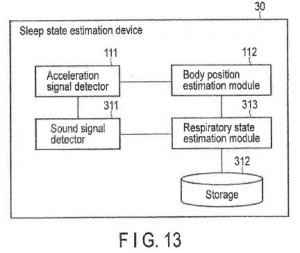 Devices for diagnosing sleep apnea and sleep-related conditions are discussed within U.S. Patent Application No. 20150374279, titled Sleep State Estimation Device, Method and Storage Medium. It discloses a sleep state estimation device attached to a user during sleep and having a first detector that detects a first signal to estimate a user state, a first estimation module that estimates a user’s state based on the signal, a second detector that detects a second signal to estimate a user state other than the first state and a second estimation module that estimates a user’s second state based on the second signal. The resulting device provides improved estimation of a user’s sleep state over conventional devices which only use a single signal to detect a user’s state. Improvements to portable medical imaging devices for patient diagnosis are featured within U.S. Patent Application No. 20160000390, filed under the title Mobile X-Ray Diagnostic Apparatus. It claims a mobile X-ray diagnostic apparatus having an X-ray generator that generates x-rays, an arm that holds the X-ray generator at one end, a main body that includes wheels, a support column turnably supported about a vertical direction as an axis to support another end of the arm and at least two input equipment arranged on the support column at different heights. The new arrangement of input switches on the support column enables easy operation of the mobile X-ray machine with one hand, improving its operability in movement.
Devices for diagnosing sleep apnea and sleep-related conditions are discussed within U.S. Patent Application No. 20150374279, titled Sleep State Estimation Device, Method and Storage Medium. It discloses a sleep state estimation device attached to a user during sleep and having a first detector that detects a first signal to estimate a user state, a first estimation module that estimates a user’s state based on the signal, a second detector that detects a second signal to estimate a user state other than the first state and a second estimation module that estimates a user’s second state based on the second signal. The resulting device provides improved estimation of a user’s sleep state over conventional devices which only use a single signal to detect a user’s state. Improvements to portable medical imaging devices for patient diagnosis are featured within U.S. Patent Application No. 20160000390, filed under the title Mobile X-Ray Diagnostic Apparatus. It claims a mobile X-ray diagnostic apparatus having an X-ray generator that generates x-rays, an arm that holds the X-ray generator at one end, a main body that includes wheels, a support column turnably supported about a vertical direction as an axis to support another end of the arm and at least two input equipment arranged on the support column at different heights. The new arrangement of input switches on the support column enables easy operation of the mobile X-ray machine with one hand, improving its operability in movement.
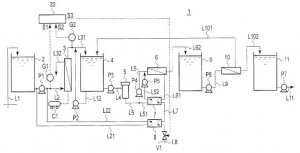 We were drawn to explore a Toshiba innovation in the field of water treatment which is reflected within U.S. Patent Application No. 20160009572, which is titled Membrane Filtration System. The membrane filtration system that would be protected includes a raw water tank, a pretreatment membrane module that separates and removes the insoluble components from the raw water, a raw water feed line having a feed pump to feed raw water from the tank to the pretreatment module, a high-pressure reverse osmosis membrane provided downstream of the pretreatment membrane module to separate and remove solutes from treated water, a low-pressure reverse osmosis membrane provided downstream of the high-pressure membrane for removing solutes remaining in water, a high-pressure line with a high-pressure pump feeding pretreated water into the high-pressure reverse osmosis membrane, a preceding power recovery unit having a positive-displacement pump to pressurize the pretreated water, a succeeding power-recovery unit having another positive-displacement pump to pressurize water, a concentrate discharge line to discharge concentrate from the high-pressure reverse osmosis membrane and transmit pressure to the positive-displacement pump, a communicating line that communicates both power recovery units and through which the concentrate from the preceding power recovery unit flows, multiple pressure transmission lines, a treated water tank, a water conveyance line and a back washing line branched from the water conveyance line. This particular configuration reduces the operational costs of membrane filtration systems designed to treat water which can be caused by the energy needed to provide the pressure required for reverse osmosis treatment systems. A technology aimed at maintaining a clean environment is at the center of U.S. Patent Application No. 20150369783, entitled Environment Evaluation Apparatus and Environment Evaluation Method for Calculating Amount of Carbon Dioxide Emission Reduction. It would protect an environment evaluation apparatus having an interface that receives a number of sheets when using electronic data instead of printing them and a controller that calculates a carbon dioxide reduction amount according to the number of sheets received by the interface. The innovation is designed to improve upon techniques to reduce carbon emissions by displaying information on a screen and not printing on a piece of paper; the system also keeps track of the amount of carbon emissions reduced in this manner.
We were drawn to explore a Toshiba innovation in the field of water treatment which is reflected within U.S. Patent Application No. 20160009572, which is titled Membrane Filtration System. The membrane filtration system that would be protected includes a raw water tank, a pretreatment membrane module that separates and removes the insoluble components from the raw water, a raw water feed line having a feed pump to feed raw water from the tank to the pretreatment module, a high-pressure reverse osmosis membrane provided downstream of the pretreatment membrane module to separate and remove solutes from treated water, a low-pressure reverse osmosis membrane provided downstream of the high-pressure membrane for removing solutes remaining in water, a high-pressure line with a high-pressure pump feeding pretreated water into the high-pressure reverse osmosis membrane, a preceding power recovery unit having a positive-displacement pump to pressurize the pretreated water, a succeeding power-recovery unit having another positive-displacement pump to pressurize water, a concentrate discharge line to discharge concentrate from the high-pressure reverse osmosis membrane and transmit pressure to the positive-displacement pump, a communicating line that communicates both power recovery units and through which the concentrate from the preceding power recovery unit flows, multiple pressure transmission lines, a treated water tank, a water conveyance line and a back washing line branched from the water conveyance line. This particular configuration reduces the operational costs of membrane filtration systems designed to treat water which can be caused by the energy needed to provide the pressure required for reverse osmosis treatment systems. A technology aimed at maintaining a clean environment is at the center of U.S. Patent Application No. 20150369783, entitled Environment Evaluation Apparatus and Environment Evaluation Method for Calculating Amount of Carbon Dioxide Emission Reduction. It would protect an environment evaluation apparatus having an interface that receives a number of sheets when using electronic data instead of printing them and a controller that calculates a carbon dioxide reduction amount according to the number of sheets received by the interface. The innovation is designed to improve upon techniques to reduce carbon emissions by displaying information on a screen and not printing on a piece of paper; the system also keeps track of the amount of carbon emissions reduced in this manner.
The encroachment of tech giants on the automotive sector continues with Toshiba’s filing of U.S. Patent Application No. 20160016475, which is titled Power Converter for Vehicle. It claims a power converter for a vehicle and having four semiconductor element modules each including a silicon carbide switching element, a silicon carbide freewheeling diode and circuits formed for three phases to perform three-phase alternating current (AC) for driving one permanent magnet synchronous motor, each of the circuits being related to single-phase AC output and having arms connecting freewheeling diodes anti-parallel to the switching elements, and then a cooling unit that cools the four semiconductor element modules. The novel layout for element modules described here reduces limitations in downsizing inverters used in railway vehicles.
 Finally, we took some time to explore an innovation in the world of superconductors which is outlined within U.S. Patent Application No. 20160005538, entitled Superconducting Coil Production Apparatus and Superconducting Coil Production Method. It would protect a superconducting coil production apparatus that produces a non-coplanar three-dimensional superconducting coil by winding a tape-like superconducting wire; the apparatus has a coil bobbin around which the superconducting wire is bound, a rotary driving unit to rotate the coil bobbin around an axis of the superconducting coil, a supply wheel supplying the superconducting wire to the coil bobbin and an adjustment driving unit that adjusts a position of the supply reel relative to a wrapping point. This apparatus supports a method for producing three-dimensional superconducting windings, which is not capable using known techniques for producing superconducting coils using tape-like wire.
Finally, we took some time to explore an innovation in the world of superconductors which is outlined within U.S. Patent Application No. 20160005538, entitled Superconducting Coil Production Apparatus and Superconducting Coil Production Method. It would protect a superconducting coil production apparatus that produces a non-coplanar three-dimensional superconducting coil by winding a tape-like superconducting wire; the apparatus has a coil bobbin around which the superconducting wire is bound, a rotary driving unit to rotate the coil bobbin around an axis of the superconducting coil, a supply wheel supplying the superconducting wire to the coil bobbin and an adjustment driving unit that adjusts a position of the supply reel relative to a wrapping point. This apparatus supports a method for producing three-dimensional superconducting windings, which is not capable using known techniques for producing superconducting coils using tape-like wire.

![[IPWatchdog Logo]](https://ipwatchdog.com/wp-content/themes/IPWatchdog%20-%202023/assets/images/temp/logo-small@2x.png)

![[[Advertisement]]](https://ipwatchdog.com/wp-content/uploads/2024/04/Patent-Litigation-2024-banner-938x313-1.jpeg)
![[Advertisement]](https://ipwatchdog.com/wp-content/uploads/2024/04/Artificial-Intelligence-2024-REPLAY-sidebar-700x500-corrected.jpg)
![[Advertisement]](https://ipwatchdog.com/wp-content/uploads/2024/04/Patent-Litigation-Masters-2024-sidebar-700x500-1.jpg)

![[Advertisement]](https://ipwatchdog.com/wp-content/uploads/2021/12/WEBINAR-336-x-280-px.png)
![[Advertisement]](https://ipwatchdog.com/wp-content/uploads/2021/12/2021-Patent-Practice-on-Demand-recorded-Feb-2021-336-x-280.jpg)
![[Advertisement]](https://ipwatchdog.com/wp-content/uploads/2021/12/Ad-4-The-Invent-Patent-System™.png)






Join the Discussion
No comments yet.